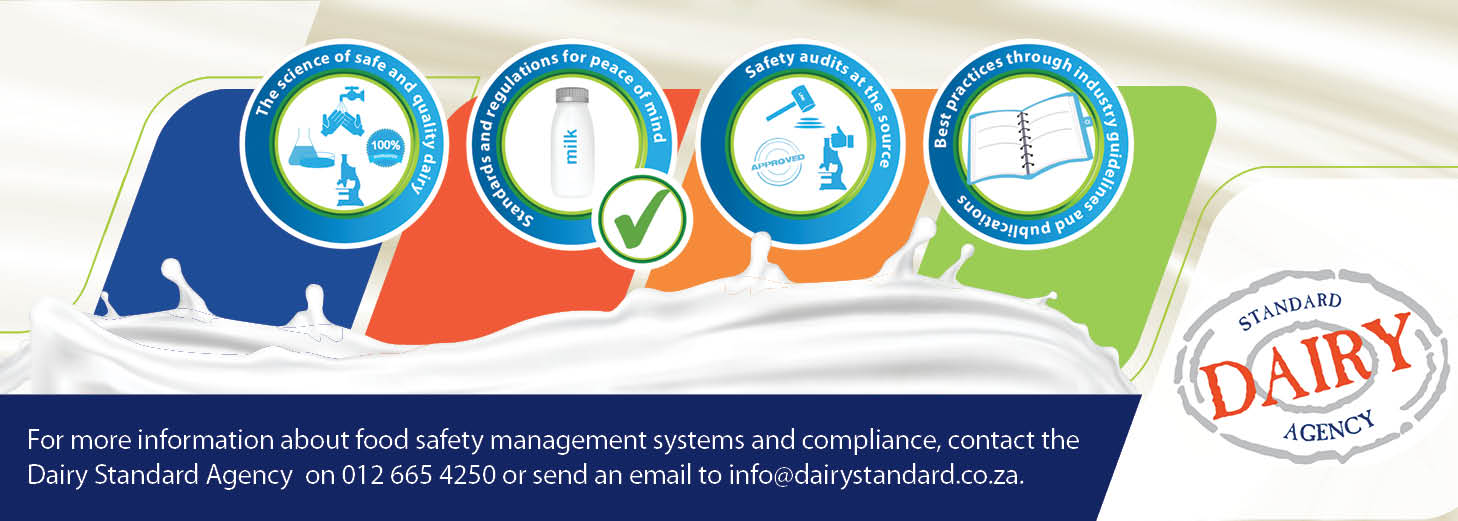
The dairy industry recognises the importance of complying with national and international standards and legislation. However, given the complex nature of the regulatory framework for milk and dairy products, it is important to note the role of national authorities and bodies such as the South African Bureau of Standards (SABS), African Organisation for Standardisation (ARSO), International Organization for Standardization (ISO), World Trade Organization, and Codex Alimentarius.
It is against this backdrop that Jompie Burger, managing director of the Dairy Standard Agency (DSA), presented a webinar on this regulatory landscape for members of the dairy industry.
Role-players, he emphasised, must stay informed of the activities of organisations such as the DSA, and be well versed in the dynamics within the organised dairy industry environment. In this regard, the DSA plays a vital role in the management of projects on behalf of Milk SA, including the Regulation and Standards Project, which contributes quite significantly to the dairy industry.
Codex Alimentarius
The Codex Alimentarius, also known as the ‘food code’, was established in 1963 by the Food and Agriculture Organization (FAO) of the United Nations and the World Health Organization. The Codex Alimentarius Commission develops harmonised international food standards, guidelines and codes of practice to protect consumer health and ensure fair practices in the food trade. It serves as a point of reverence for various regulatory documents, such as those of the SABS, ISO and ARSO – the latter aspires to develop a minimum of 75 standards for dairy products in Africa in the next four years in a bid to harmonise the continent’s dairy trade.
The South African dairy industry’s involvement with the International Dairy Federation (IDF) is crucial for remaining at the forefront of international dairy matters. South Africa is therefore well represented and actively participates in the IDF’s standing committees. Milk SA’s Regulation and Standards Project contributes to these committees – the discussions raised during proceedings serve as preparation for Codex sessions on imports, exports, food labelling, e-commerce and food additives.
Food safety
Food safety is the focus of the Foodstuffs, Cosmetics and Disinfectants Act, 1972 (Act 54 of 1972), which assists in protecting consumers from misleading claims and making informed choices about food safety and health claims.
Front-of-pack nutrition labelling (FOPNL) refers to systems that are presented on the front of food packaging with the aim of promoting healthier choices. Draft regulations in this regard (R3337) were published in 2023. The Department of Health’s approach to FOPNL labelling was the biggest challenge in this regard. Milk SA’s task force submitted a scientific document explaining the industry’s position regarding the unique nutritional composition of especially dairy products. Final comments were submitted on 21 July 2023. It has been noted since that some dairy products are excluded from specific clauses relating to front-of-pack labelling and warning signs.
Regulation 1555 of November 1997 concerns dairy and dairy products. Its primary purpose is to separate the microbiological specifications of dairy from other foods, due to the complex nature of dairy. Research is currently underway regarding the development of applicable microbiological criteria that will serve as minimum food safety criteria for dairy. This project is already in an advanced stage and will contribute to draft regulations for the dairy industry.
Product descriptions
Section 6 of the Agricultural Product Standards Act, 1990 (Act 119 of 1990) concerns the prohibition of false or misleading food product descriptions. Burger encouraged consumers to study product labels carefully and contact the relevant authorities and the DSA if there is uncertainty as to its legitimacy.
Take plant-based ‘butter’ for example – the ‘butter’ in question features a registered trademark but is not in fact registered. ‘Butter’ creates the impression that the product contains dairy, which it does not. The Department of Agriculture, Land Reform and Rural Development’s (DALRRD) Food Safety and Quality Assurance (FSQA) Directorate took up the matter with the manufacturer and granted a dispensation, after which the product had to be removed from retail shelves. This dispensation expires in October 2024.
A hot topic is claims on packaging stating that dairy products are rBST (recombinant bovine somatotropin) free. There are concerns about misleading claims in this regard and talks between the industry and DALRRD continue.
Regulation 1510 of 2019 concerns dairy and imitation dairy products. Milk SA’s technical working group has been actively working on this since 2022 and the initial draft document was circulated for comment in July 2022. The design proposal was submitted to the DALRRD at the end of 2023 and expectations are that good progress will be made early in 2024.
Residue monitoring programme
The dairy industry’s national chemical residue monitoring programme has been inactive since 2000. South Africa has received regular visits from the European Union (EU) since 2023, aimed at assisting with the establishment of a dairy residue programme to promote exports to the EU. Several African countries have already agreed to comply with the EU system. Africa’s free trade agreements should be closely monitored.
For enquiries, send an email to Jompie Burger at jompie@dairystandard.co.za
Written by: Christal-Lize Muller, Plaas Media




